![]()
![]()
![]()
Use LEFT and RIGHT arrow keys to navigate between flashcards;
Use UP and DOWN arrow keys to flip the card;
H to show hint;
A reads text to speech;
73 Cards in this Set
- Front
- Back
|
What happens when an electron travels along a wire
|
a magnetic field is created
|
|
|
What does an the magnetic field surrounding a current look like
|
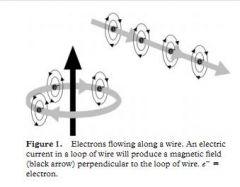
|
|
|
What direction is the magnetic field formed from a charge moving through a wire
|
perpendicular (look at last slide)
|
|
|
How many protons does a hydrogen atom have
|
1 (no neutrons) atomic mass 1
|
|
|
Is a hydrogen proton a positively charged and spins
about its axis (like a child’s spinning top). |
yes
|
|
|
What does a hydrogen proton look like
|
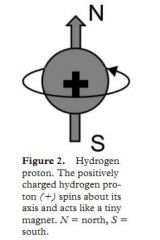
|
|
|
Do the hydrogen protons in our body act like tiny magnets
|
yes
|
|
|
Where does the main magnetic field of MR come from
|
The main magnetic field of anMR system comes
from a large electric current flowing through wires that are formed into a loop in the magnet of the |
|
|
What does the magnetic field from a superconducting magnet look like
|
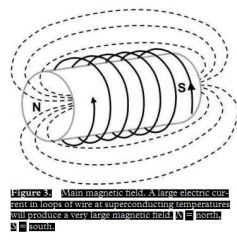
|
|
|
What is the direction of the main magnetic field
|
the z axis
|
|
|
What happens to the protons (little magnets) when a magnetic field is applied
|
they turn parallel or antiparallel
|
|
|
What do protons look like when a magnetic field is applied
|
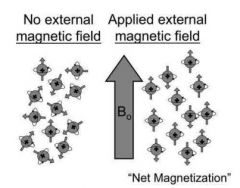
|
|
|
What is the direction of the magnetic field
|
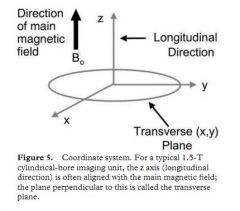
|
|
|
Do you need a constant supply of electricity for a superconducting magnet
|
no, The magnet
can be “ramped” with a power supply (to inject electric current into the coils of wire), and the power supply can then be removed. The imaging system can retain this electric current for many years (with no need to inject additional electric current) |
|
|
What are the directions on the MR scanner
|
z- head to toe
x- left to right y- anterior to posterior |
|
|
Does the liquid helium levels in the magnet need to be changed
|
The liquid helium levels in the magnet will need
to be filled at regular intervals (once per month to once every few years, depending on the magnet design). |
|
|
What happens to the protons of the body when put in a magnetic field
|
When we place these protons in a strong mag-
netic field (called B0), some will tend to align in the direction of the magnetic field and some will tend to align in a direction opposite to the mag- netic field. The magnetic fields from many pro- tons will cancel out, but a slight excess of the pro- tons will be aligned with the main magnetic field, producing a “net magnetization” that is aligned parallel to the main magnetic field. |
|
|
What is the source of the MR signal
|
the net magnetization
|
|
|
Do protons always precess
|
yes
|
|
|
What happens to the frequency of the precession in a magnetic field
|
it increases
|
|
|
What is precession akin to
|
a spinning top
|
|
|
What is the formula for precessional frequency
|
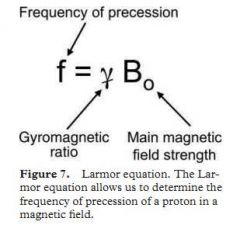
|
|
|
What is the name of the formula that allows us to determine precession
|
larmor equation
|
|
|
What is the gyromagnetic ratio
|
42.6 megahertz per tesla
|
|
|
What is the magnetic field strength
|
depends on magnetic design
|
|
|
What is the cause of radiofrequency energy
|
Radiofrequency (RF) energy comes in the form of
rapidly changing magnetic and electric fields gen- erated by electrons traveling through loops of wir with the direction of current flow rapidly changing back and forth at “radio frequencies.” The magnetic field (generated by the flow of electrons) will also rapidly change directions. |
|
|
Why must MR systems be shielded from external RF signals
|
Radio and
television stations broadcast at frequencies in units of megahertz, so a broadcast at 89.9 on your FMdial is really at 89.9MHz. This RF energy is not far from the precessional frequencies of a 1.5-T magnet (64MHz) |
|
|
How is the RF energy transmitted in an MR system
|
RF coil
|
|
|
What is the RF pulse
|
this is the short period of time that the RF energy is transmitted
|
|
|
What must be figured out if the RF pulse is going to work
|
This transmitted RF pulse must be at the
precessional frequency of the protons (calculated via the Larmor equation) in order for resonance to occur and for efficient transfer of energy from the RF coil to the protons. |
|
|
What happens to the protons in our body when they are placed in the vicinity of a strong magnetic field
|
The net magnetizaion points in the direction of the magnetic field (longitudinal direction)
|
|
|
What happens when the RF pulse hits the protons in the magetic field
|
the net magnetization rotates away from the longitudinal direction
|
|
|
What is another term for the amount of rotation caused by the RF pulse
|
flip angle
|
|
|
What determines the amount of rotation by protons in a magnetic field once the RF pulse hits them
|
the strength and duration of the RF pulse
|
|
|
What is called if the RF pulse rotates the net magnetization in the transverse plane
|
a 90 degree RF pulse
|
|
|
What is it called if the RF pulse rotates the net magnetization 180 degrees in the z-direction
|
180 degree RF pulse
|
|
|
Can the RF pulse be adjusted to flip the net magnetization to any angle
|
yes
|
|
|
What type of RF pulses are important when discussing Spine Echo sequences
|
90 and 180 RF pulses
|
|
|
What type of RF pulses are utilized in gradient echo sequences
|
smaller angle pulse (less than 90 i think)
|
|
|
At baseline what is the magnetization of the protons in the superconductor magnet
|
longitudinal magnetization
|
|
|
When a 90 degree RF pulse is given to longitudinaly magnetized proton what is it called now
|
transverse magnetization
(the longitudinal magnetization is zero) |
|
|
Once the pulse is discontinued what happens to the protons that have been excited to being transveres position
|
they start moving back towards longitudinal magnetization
|
|
|
What is it called when the protons start moving back towards longitudinal magnetization
|
longitudinal relaxation
|
|
|
What is longitudinal relaxation
|
when the protons start moving back towards longitudinal magnetization after the RF pulse is discontinued
|
|
|
What is does it look like when a proton is excited to the transverse plane following an RF pulse
|

|
|
|
What does longitudinal relaxation look like
|
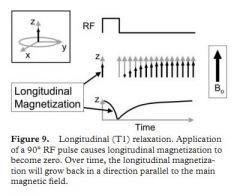
|
|
|
What is another name for longitudinal relaxation
|
T1
|
|
|
What is T1 relaxation
|
the rate at which longitudinal magnetization grows back
|
|
|
What is the fundamental concept of T1 weighting
|
The rate at which this lon-gitudinal magnetization grows back is different for
protons associated with different tissues and is the fundamental source of contrast in T1-weighted images. |
|
|
Does the strength of the magnetic field effect T1 images
|
yes
|
|
|
What is the definition of T1
|
the time it takes for longitudinal magnetization to reach 63% of its final value (assuming a 90 degree pulse)
|
|
|
What does the T1 curve look like
|
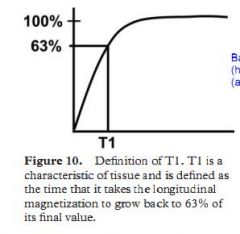
|
|
|
Will the longitudinal magnetization of tissues with different values of T1 grow back in the longitudinal direction at different rates
|
yes
|
|
|
Do different tissues have different rates of T1 relaxation
|
yes
|
|
|
What has a longer T1 time; white matter or csf
|
csf
|
|
|
Are tissue with a longer T1 time dark on T1W imaging
|
yes
|
|
|
Are tissues with a short T1 time brighter on T1 W images
|
yes
|
|
|
What do the T1 curves of WM, GM and CSF look like
|
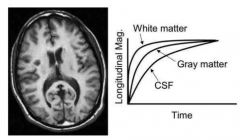
|
|
|
How do you create greater contrast between CSF and White matter
|
create an image during a time when the images are widely seperated
|
|
|
If the image was created during a time when the curves where widely seperated (previous image) what could be said
|
the image is T1W (and would have a lot of contrast)
|
|
|
What happens to the protons after a 90 degree RF pulse
|
they rotate with a net magnetization in the transverse plane
|
|
|
During the RF pulse what happens to all the protons in the transverse plan
|
they precess together and are in phase
|
|
|
What happens to the protons after the RF pulse is discontinued
|
not only do they start to move in the longitudinal direction but they become out of phase in the transverse direction
|
|
|
What does dephasing in the transverse phase look like
|
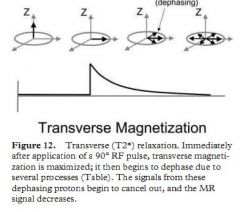
|
|
|
What are the causes of T2 Dephasing
|

|
|
|
What are all the causes of T2 dephasing
|
spin spin interactions
magnetic field inhomogenteities magnetic susceptibility chemical shift effects |
|
|
What is magnetic field inhomogeneities
|
owing to hardware limita-tions, the main magnetic field is not perfectly ho-mogeneous across the imaging volume. Thus,
protons that experience slightly different mag-netic field strengths will precess at slightly differ-ent Larmor frequencies. Protons that were in phase immediately after the 90° RF pulse, be-cause they are precessing at slightly different fre-quencies, will begin to dephase |
|
|
Does dephasing normally occur because of all 4 of these effects
|
yes
|
|
|
What is it called when dephasing is due to spin spin interactions
magnetic field inhomogenteities magnetic susceptibility chemical shift effects |
T2 star decay or T2 relaxation
|
|
|
What is called when all 4 effects cause T2 dephasing
|
T2 star decay or T2 relaxation
|
|
|
What is T2 relaxation (without the star)
|
The
dephasing due to three of the effects can be re-versed through a special “trick” discussed later. In this case, when dephasing is due only to the effect called spin-spin interactions, the dephasing may be called T2 decay or T2 relaxation |
|
|
What is the only type of interaction that causes T2 relaxation (without the star)
|
spin-spin interaction
|
|
|
What is T2 decay or T2 relaxation
|
dephasing that is just due to spin spin interaction
|

